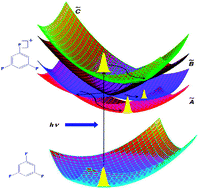The Jahn–Teller and pseudo-Jahn–Teller effects in the low-lying electronic states of 1,3,5-trifluorobenzene radical cation†
Abstract
Static and dynamic aspects of the multimode Jahn–Teller (JT) and pseudo-Jahn–Teller (PJT) interactions in the low-lying electronic states of ![[X with combining tilde]](https://www.rsc.org/images/entities/i_char_0058_0303.gif) 2E″) of TFBZ+ is energetically well separated from its excited states. The first three excited electronic states (
2E″) of TFBZ+ is energetically well separated from its excited states. The first three excited electronic states ( ,
, ![[B with combining tilde]](https://www.rsc.org/images/entities/i_char_0042_0303.gif) 2E′ and
2E′ and  ) are however, energetically close. A sequence of low-energy conical intersections underlying the JT and PJT interactions among these electronic states is established. Nonadiabatic effects due to these intersections on the vibronic dynamics are examined in detail. The theoretical results are compared with the low resolution and also better resolved
) are however, energetically close. A sequence of low-energy conical intersections underlying the JT and PJT interactions among these electronic states is established. Nonadiabatic effects due to these intersections on the vibronic dynamics are examined in detail. The theoretical results are compared with the low resolution and also better resolved


 Please wait while we load your content...
Please wait while we load your content...